Construction Management: Site Communication, WHS, and Material Supply
VerifiedAdded on 2023/06/14
|18
|3436
|167
Report
AI Summary
This report provides a comprehensive analysis of site communication processes, WHS (Work Health and Safety), and material supply considerations for a medium-rise apartment project. It includes a sample letter for stakeholder communication regarding site meetings, detailing the purpose, schedule, and attendees. The report also outlines first aid requirements according to WSIA, plant and equipment safety protocols, and a safe work method statement (SWMS) for excavators, addressing potential hazards and control measures. Furthermore, it presents a safety induction plan encompassing site-specific rules, workplace layout, on-job training, and emergency response procedures. Finally, the report identifies materials and equipment with long lead times and presents an order bar chart for effective material management. Desklib offers this and many other solved assignments for students.

Medium Rise Apartment 1
Medium Rise Apartment
Name
Course
Professor
University
City/state
Date
Medium Rise Apartment
Name
Course
Professor
University
City/state
Date
Paraphrase This Document
Need a fresh take? Get an instant paraphrase of this document with our AI Paraphraser
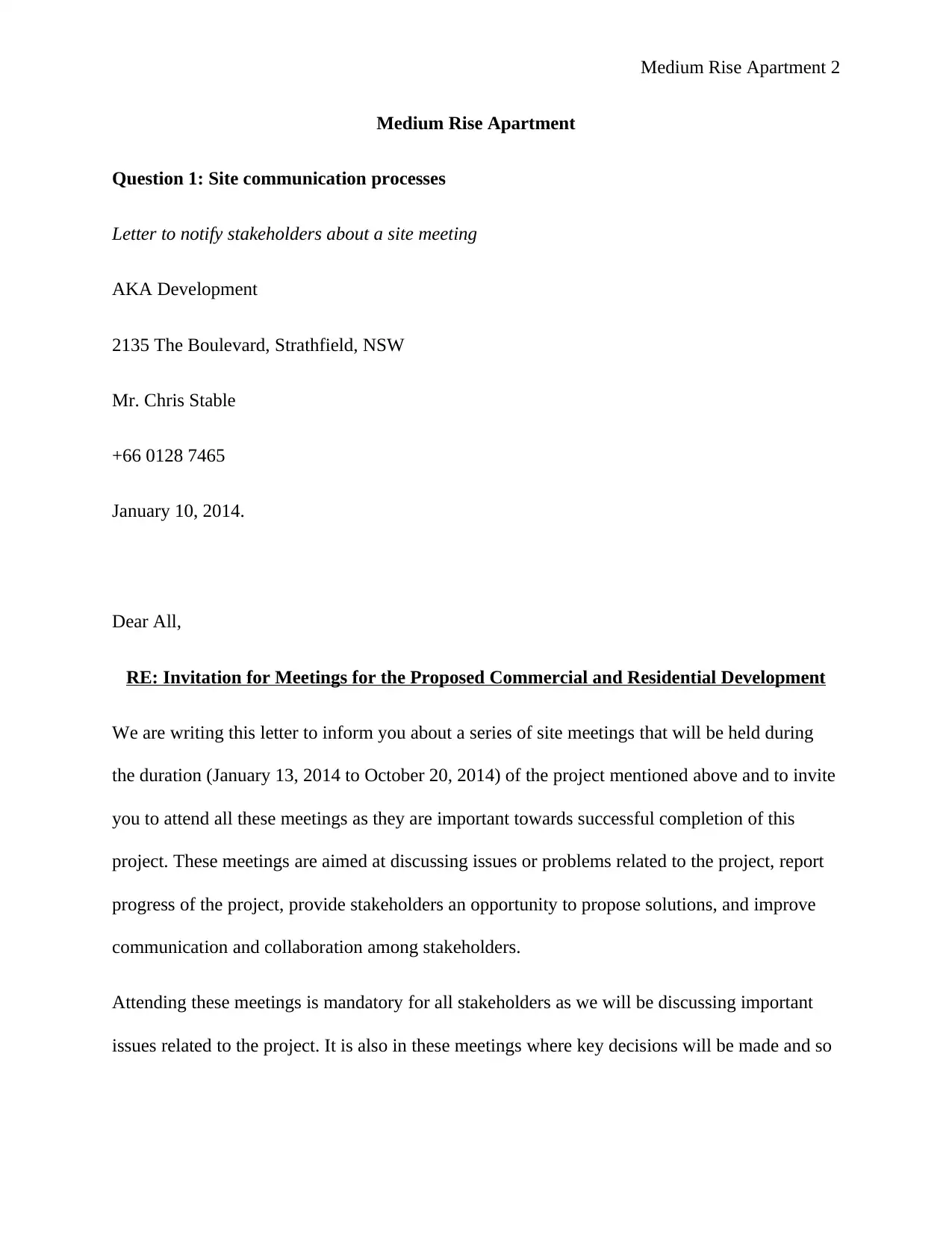
Medium Rise Apartment 2
Medium Rise Apartment
Question 1: Site communication processes
Letter to notify stakeholders about a site meeting
AKA Development
2135 The Boulevard, Strathfield, NSW
Mr. Chris Stable
+66 0128 7465
January 10, 2014.
Dear All,
RE: Invitation for Meetings for the Proposed Commercial and Residential Development
We are writing this letter to inform you about a series of site meetings that will be held during
the duration (January 13, 2014 to October 20, 2014) of the project mentioned above and to invite
you to attend all these meetings as they are important towards successful completion of this
project. These meetings are aimed at discussing issues or problems related to the project, report
progress of the project, provide stakeholders an opportunity to propose solutions, and improve
communication and collaboration among stakeholders.
Attending these meetings is mandatory for all stakeholders as we will be discussing important
issues related to the project. It is also in these meetings where key decisions will be made and so
Medium Rise Apartment
Question 1: Site communication processes
Letter to notify stakeholders about a site meeting
AKA Development
2135 The Boulevard, Strathfield, NSW
Mr. Chris Stable
+66 0128 7465
January 10, 2014.
Dear All,
RE: Invitation for Meetings for the Proposed Commercial and Residential Development
We are writing this letter to inform you about a series of site meetings that will be held during
the duration (January 13, 2014 to October 20, 2014) of the project mentioned above and to invite
you to attend all these meetings as they are important towards successful completion of this
project. These meetings are aimed at discussing issues or problems related to the project, report
progress of the project, provide stakeholders an opportunity to propose solutions, and improve
communication and collaboration among stakeholders.
Attending these meetings is mandatory for all stakeholders as we will be discussing important
issues related to the project. It is also in these meetings where key decisions will be made and so
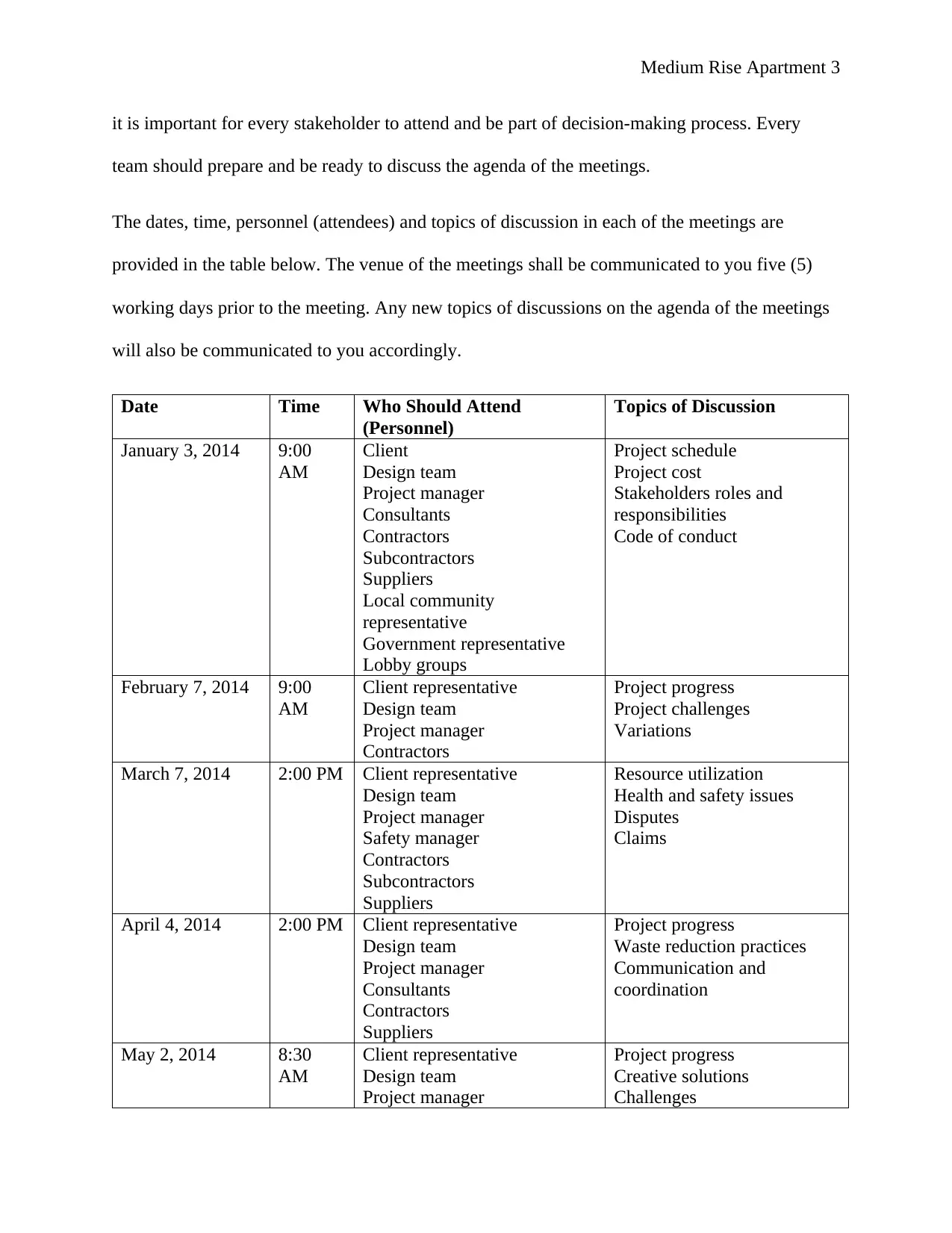
Medium Rise Apartment 3
it is important for every stakeholder to attend and be part of decision-making process. Every
team should prepare and be ready to discuss the agenda of the meetings.
The dates, time, personnel (attendees) and topics of discussion in each of the meetings are
provided in the table below. The venue of the meetings shall be communicated to you five (5)
working days prior to the meeting. Any new topics of discussions on the agenda of the meetings
will also be communicated to you accordingly.
Date Time Who Should Attend
(Personnel)
Topics of Discussion
January 3, 2014 9:00
AM
Client
Design team
Project manager
Consultants
Contractors
Subcontractors
Suppliers
Local community
representative
Government representative
Lobby groups
Project schedule
Project cost
Stakeholders roles and
responsibilities
Code of conduct
February 7, 2014 9:00
AM
Client representative
Design team
Project manager
Contractors
Project progress
Project challenges
Variations
March 7, 2014 2:00 PM Client representative
Design team
Project manager
Safety manager
Contractors
Subcontractors
Suppliers
Resource utilization
Health and safety issues
Disputes
Claims
April 4, 2014 2:00 PM Client representative
Design team
Project manager
Consultants
Contractors
Suppliers
Project progress
Waste reduction practices
Communication and
coordination
May 2, 2014 8:30
AM
Client representative
Design team
Project manager
Project progress
Creative solutions
Challenges
it is important for every stakeholder to attend and be part of decision-making process. Every
team should prepare and be ready to discuss the agenda of the meetings.
The dates, time, personnel (attendees) and topics of discussion in each of the meetings are
provided in the table below. The venue of the meetings shall be communicated to you five (5)
working days prior to the meeting. Any new topics of discussions on the agenda of the meetings
will also be communicated to you accordingly.
Date Time Who Should Attend
(Personnel)
Topics of Discussion
January 3, 2014 9:00
AM
Client
Design team
Project manager
Consultants
Contractors
Subcontractors
Suppliers
Local community
representative
Government representative
Lobby groups
Project schedule
Project cost
Stakeholders roles and
responsibilities
Code of conduct
February 7, 2014 9:00
AM
Client representative
Design team
Project manager
Contractors
Project progress
Project challenges
Variations
March 7, 2014 2:00 PM Client representative
Design team
Project manager
Safety manager
Contractors
Subcontractors
Suppliers
Resource utilization
Health and safety issues
Disputes
Claims
April 4, 2014 2:00 PM Client representative
Design team
Project manager
Consultants
Contractors
Suppliers
Project progress
Waste reduction practices
Communication and
coordination
May 2, 2014 8:30
AM
Client representative
Design team
Project manager
Project progress
Creative solutions
Challenges
⊘ This is a preview!⊘
Do you want full access?
Subscribe today to unlock all pages.

Trusted by 1+ million students worldwide
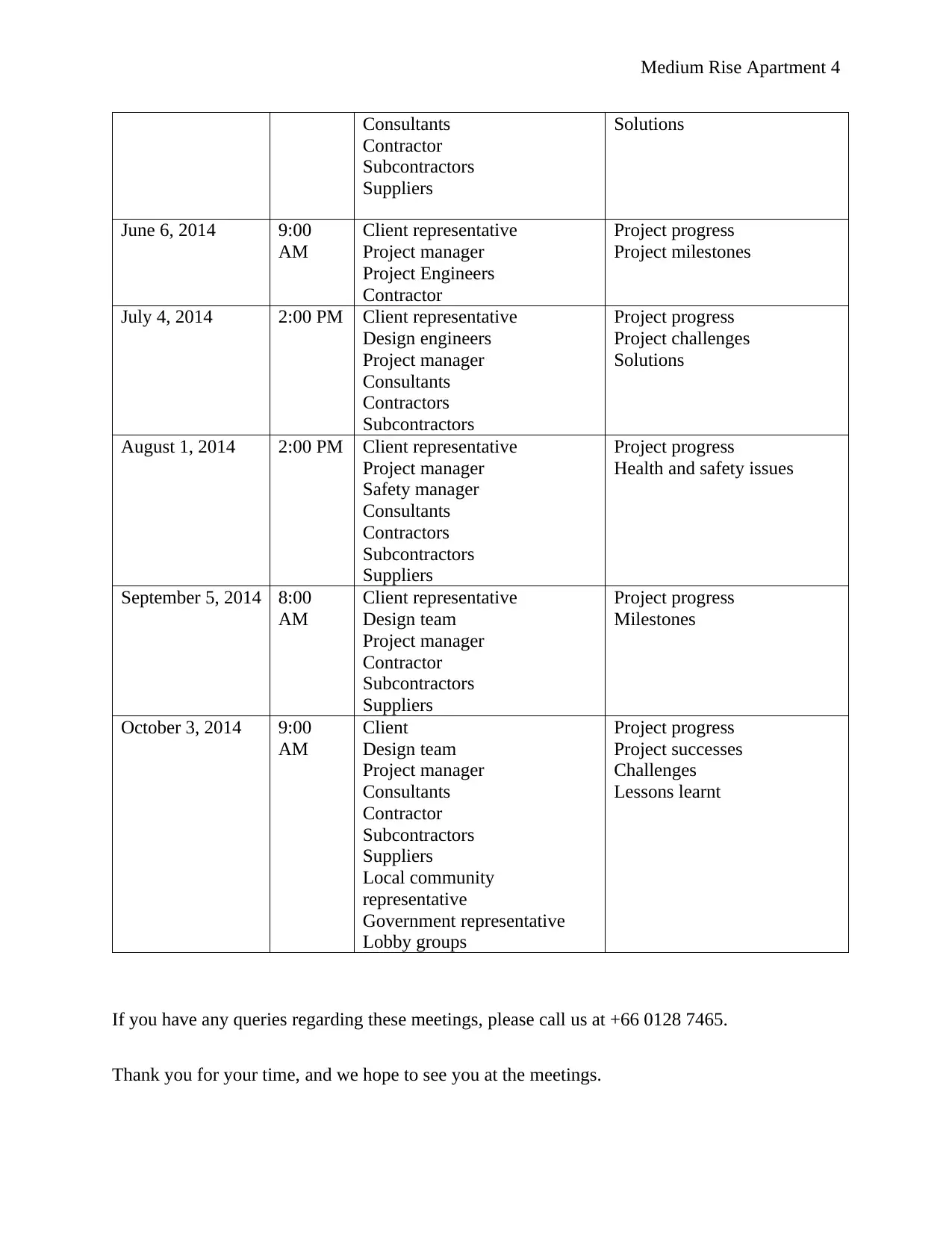
Medium Rise Apartment 4
Consultants
Contractor
Subcontractors
Suppliers
Solutions
June 6, 2014 9:00
AM
Client representative
Project manager
Project Engineers
Contractor
Project progress
Project milestones
July 4, 2014 2:00 PM Client representative
Design engineers
Project manager
Consultants
Contractors
Subcontractors
Project progress
Project challenges
Solutions
August 1, 2014 2:00 PM Client representative
Project manager
Safety manager
Consultants
Contractors
Subcontractors
Suppliers
Project progress
Health and safety issues
September 5, 2014 8:00
AM
Client representative
Design team
Project manager
Contractor
Subcontractors
Suppliers
Project progress
Milestones
October 3, 2014 9:00
AM
Client
Design team
Project manager
Consultants
Contractor
Subcontractors
Suppliers
Local community
representative
Government representative
Lobby groups
Project progress
Project successes
Challenges
Lessons learnt
If you have any queries regarding these meetings, please call us at +66 0128 7465.
Thank you for your time, and we hope to see you at the meetings.
Consultants
Contractor
Subcontractors
Suppliers
Solutions
June 6, 2014 9:00
AM
Client representative
Project manager
Project Engineers
Contractor
Project progress
Project milestones
July 4, 2014 2:00 PM Client representative
Design engineers
Project manager
Consultants
Contractors
Subcontractors
Project progress
Project challenges
Solutions
August 1, 2014 2:00 PM Client representative
Project manager
Safety manager
Consultants
Contractors
Subcontractors
Suppliers
Project progress
Health and safety issues
September 5, 2014 8:00
AM
Client representative
Design team
Project manager
Contractor
Subcontractors
Suppliers
Project progress
Milestones
October 3, 2014 9:00
AM
Client
Design team
Project manager
Consultants
Contractor
Subcontractors
Suppliers
Local community
representative
Government representative
Lobby groups
Project progress
Project successes
Challenges
Lessons learnt
If you have any queries regarding these meetings, please call us at +66 0128 7465.
Thank you for your time, and we hope to see you at the meetings.
Paraphrase This Document
Need a fresh take? Get an instant paraphrase of this document with our AI Paraphraser
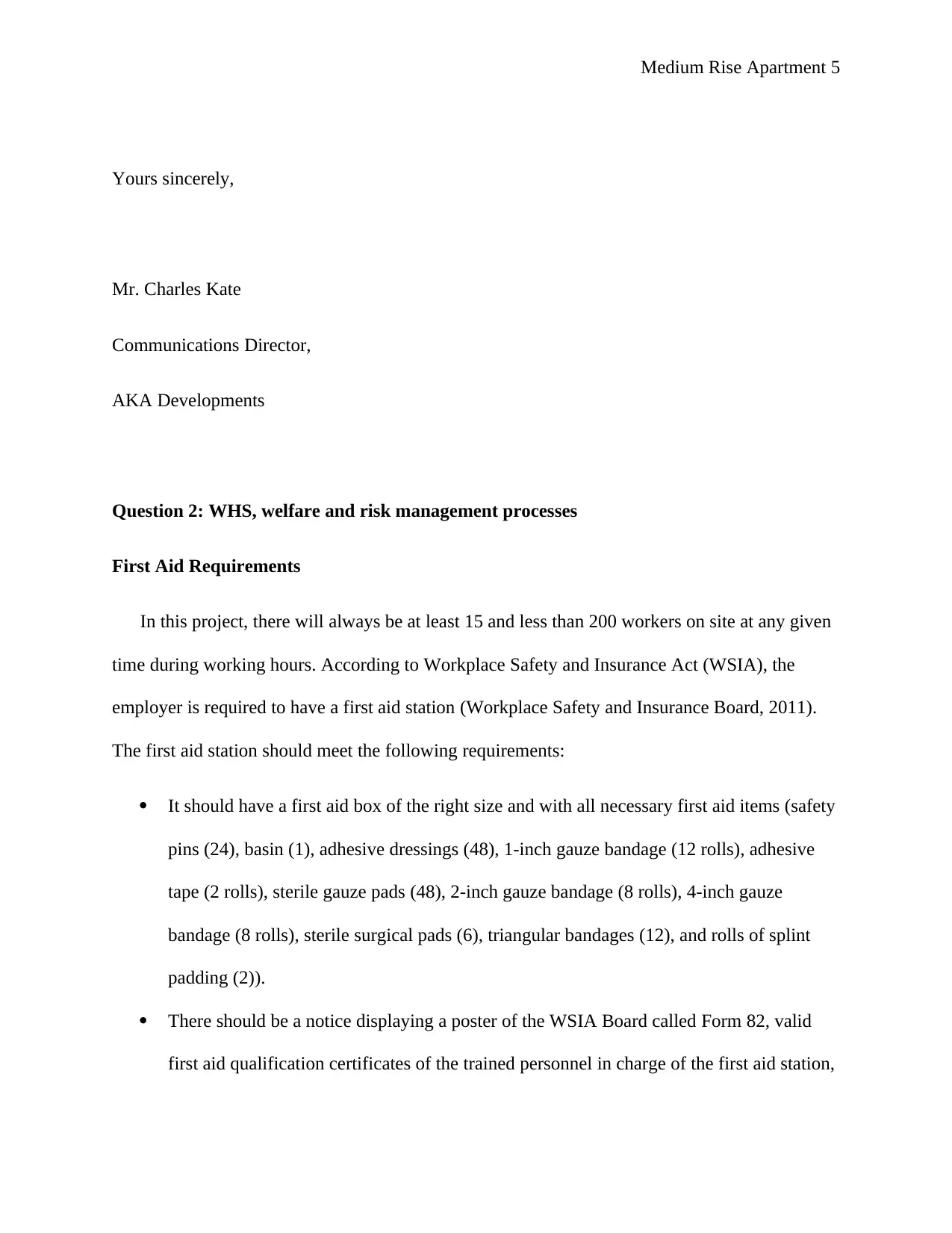
Medium Rise Apartment 5
Yours sincerely,
Mr. Charles Kate
Communications Director,
AKA Developments
Question 2: WHS, welfare and risk management processes
First Aid Requirements
In this project, there will always be at least 15 and less than 200 workers on site at any given
time during working hours. According to Workplace Safety and Insurance Act (WSIA), the
employer is required to have a first aid station (Workplace Safety and Insurance Board, 2011).
The first aid station should meet the following requirements:
It should have a first aid box of the right size and with all necessary first aid items (safety
pins (24), basin (1), adhesive dressings (48), 1-inch gauze bandage (12 rolls), adhesive
tape (2 rolls), sterile gauze pads (48), 2-inch gauze bandage (8 rolls), 4-inch gauze
bandage (8 rolls), sterile surgical pads (6), triangular bandages (12), and rolls of splint
padding (2)).
There should be a notice displaying a poster of the WSIA Board called Form 82, valid
first aid qualification certificates of the trained personnel in charge of the first aid station,
Yours sincerely,
Mr. Charles Kate
Communications Director,
AKA Developments
Question 2: WHS, welfare and risk management processes
First Aid Requirements
In this project, there will always be at least 15 and less than 200 workers on site at any given
time during working hours. According to Workplace Safety and Insurance Act (WSIA), the
employer is required to have a first aid station (Workplace Safety and Insurance Board, 2011).
The first aid station should meet the following requirements:
It should have a first aid box of the right size and with all necessary first aid items (safety
pins (24), basin (1), adhesive dressings (48), 1-inch gauze bandage (12 rolls), adhesive
tape (2 rolls), sterile gauze pads (48), 2-inch gauze bandage (8 rolls), 4-inch gauze
bandage (8 rolls), sterile surgical pads (6), triangular bandages (12), and rolls of splint
padding (2)).
There should be a notice displaying a poster of the WSIA Board called Form 82, valid
first aid qualification certificates of the trained personnel in charge of the first aid station,
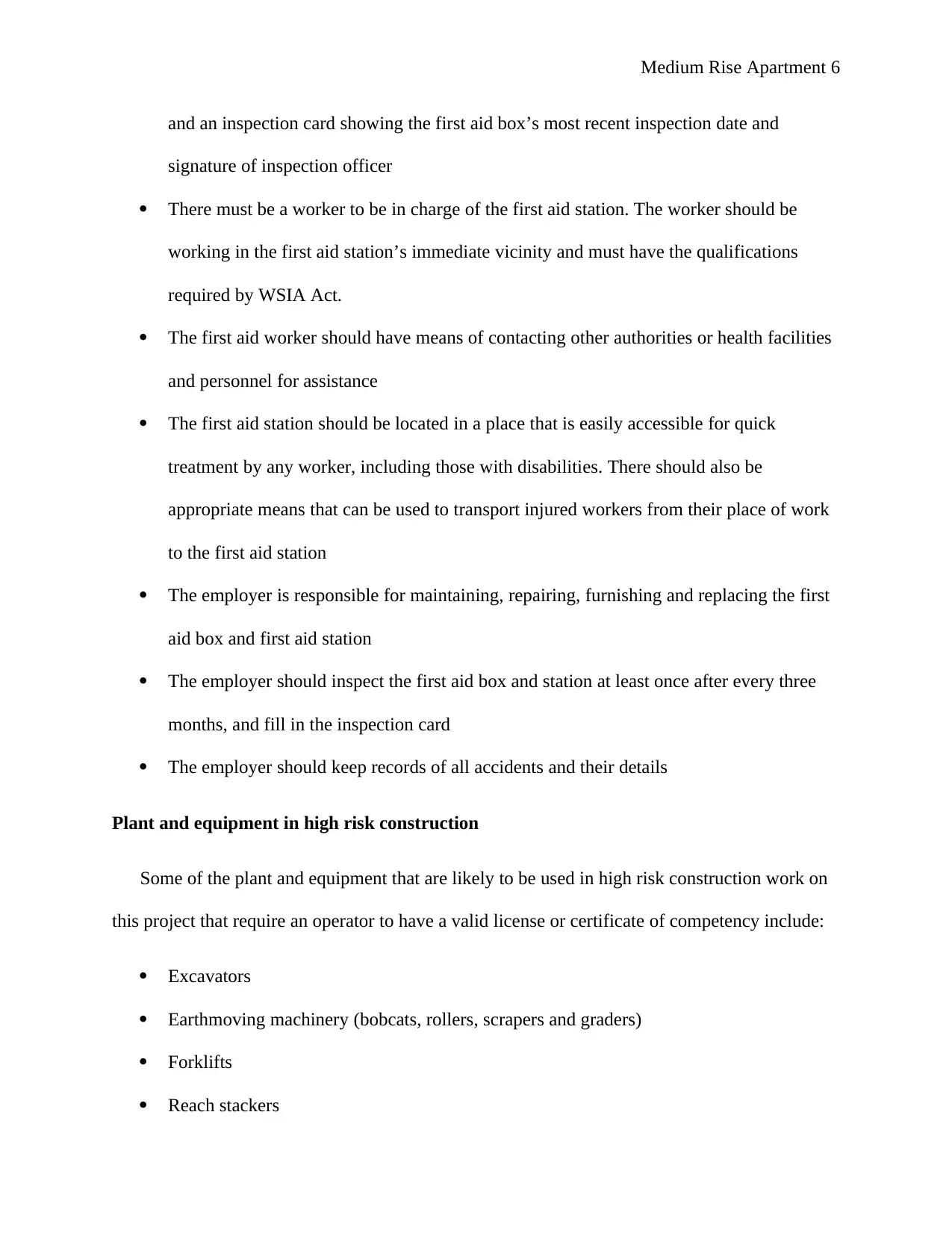
Medium Rise Apartment 6
and an inspection card showing the first aid box’s most recent inspection date and
signature of inspection officer
There must be a worker to be in charge of the first aid station. The worker should be
working in the first aid station’s immediate vicinity and must have the qualifications
required by WSIA Act.
The first aid worker should have means of contacting other authorities or health facilities
and personnel for assistance
The first aid station should be located in a place that is easily accessible for quick
treatment by any worker, including those with disabilities. There should also be
appropriate means that can be used to transport injured workers from their place of work
to the first aid station
The employer is responsible for maintaining, repairing, furnishing and replacing the first
aid box and first aid station
The employer should inspect the first aid box and station at least once after every three
months, and fill in the inspection card
The employer should keep records of all accidents and their details
Plant and equipment in high risk construction
Some of the plant and equipment that are likely to be used in high risk construction work on
this project that require an operator to have a valid license or certificate of competency include:
Excavators
Earthmoving machinery (bobcats, rollers, scrapers and graders)
Forklifts
Reach stackers
and an inspection card showing the first aid box’s most recent inspection date and
signature of inspection officer
There must be a worker to be in charge of the first aid station. The worker should be
working in the first aid station’s immediate vicinity and must have the qualifications
required by WSIA Act.
The first aid worker should have means of contacting other authorities or health facilities
and personnel for assistance
The first aid station should be located in a place that is easily accessible for quick
treatment by any worker, including those with disabilities. There should also be
appropriate means that can be used to transport injured workers from their place of work
to the first aid station
The employer is responsible for maintaining, repairing, furnishing and replacing the first
aid box and first aid station
The employer should inspect the first aid box and station at least once after every three
months, and fill in the inspection card
The employer should keep records of all accidents and their details
Plant and equipment in high risk construction
Some of the plant and equipment that are likely to be used in high risk construction work on
this project that require an operator to have a valid license or certificate of competency include:
Excavators
Earthmoving machinery (bobcats, rollers, scrapers and graders)
Forklifts
Reach stackers
⊘ This is a preview!⊘
Do you want full access?
Subscribe today to unlock all pages.

Trusted by 1+ million students worldwide
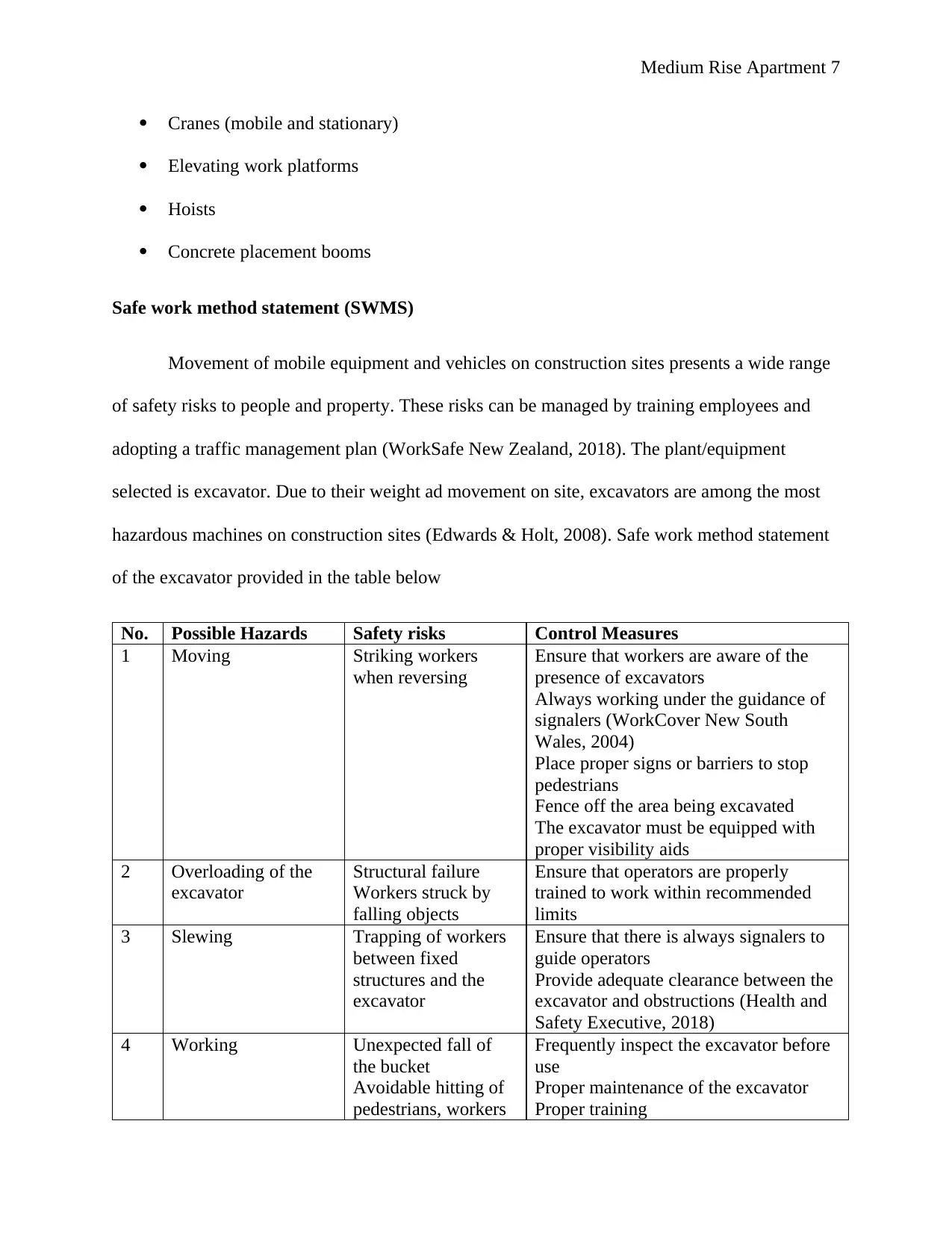
Medium Rise Apartment 7
Cranes (mobile and stationary)
Elevating work platforms
Hoists
Concrete placement booms
Safe work method statement (SWMS)
Movement of mobile equipment and vehicles on construction sites presents a wide range
of safety risks to people and property. These risks can be managed by training employees and
adopting a traffic management plan (WorkSafe New Zealand, 2018). The plant/equipment
selected is excavator. Due to their weight ad movement on site, excavators are among the most
hazardous machines on construction sites (Edwards & Holt, 2008). Safe work method statement
of the excavator provided in the table below
No. Possible Hazards Safety risks Control Measures
1 Moving Striking workers
when reversing
Ensure that workers are aware of the
presence of excavators
Always working under the guidance of
signalers (WorkCover New South
Wales, 2004)
Place proper signs or barriers to stop
pedestrians
Fence off the area being excavated
The excavator must be equipped with
proper visibility aids
2 Overloading of the
excavator
Structural failure
Workers struck by
falling objects
Ensure that operators are properly
trained to work within recommended
limits
3 Slewing Trapping of workers
between fixed
structures and the
excavator
Ensure that there is always signalers to
guide operators
Provide adequate clearance between the
excavator and obstructions (Health and
Safety Executive, 2018)
4 Working Unexpected fall of
the bucket
Avoidable hitting of
pedestrians, workers
Frequently inspect the excavator before
use
Proper maintenance of the excavator
Proper training
Cranes (mobile and stationary)
Elevating work platforms
Hoists
Concrete placement booms
Safe work method statement (SWMS)
Movement of mobile equipment and vehicles on construction sites presents a wide range
of safety risks to people and property. These risks can be managed by training employees and
adopting a traffic management plan (WorkSafe New Zealand, 2018). The plant/equipment
selected is excavator. Due to their weight ad movement on site, excavators are among the most
hazardous machines on construction sites (Edwards & Holt, 2008). Safe work method statement
of the excavator provided in the table below
No. Possible Hazards Safety risks Control Measures
1 Moving Striking workers
when reversing
Ensure that workers are aware of the
presence of excavators
Always working under the guidance of
signalers (WorkCover New South
Wales, 2004)
Place proper signs or barriers to stop
pedestrians
Fence off the area being excavated
The excavator must be equipped with
proper visibility aids
2 Overloading of the
excavator
Structural failure
Workers struck by
falling objects
Ensure that operators are properly
trained to work within recommended
limits
3 Slewing Trapping of workers
between fixed
structures and the
excavator
Ensure that there is always signalers to
guide operators
Provide adequate clearance between the
excavator and obstructions (Health and
Safety Executive, 2018)
4 Working Unexpected fall of
the bucket
Avoidable hitting of
pedestrians, workers
Frequently inspect the excavator before
use
Proper maintenance of the excavator
Proper training
Paraphrase This Document
Need a fresh take? Get an instant paraphrase of this document with our AI Paraphraser
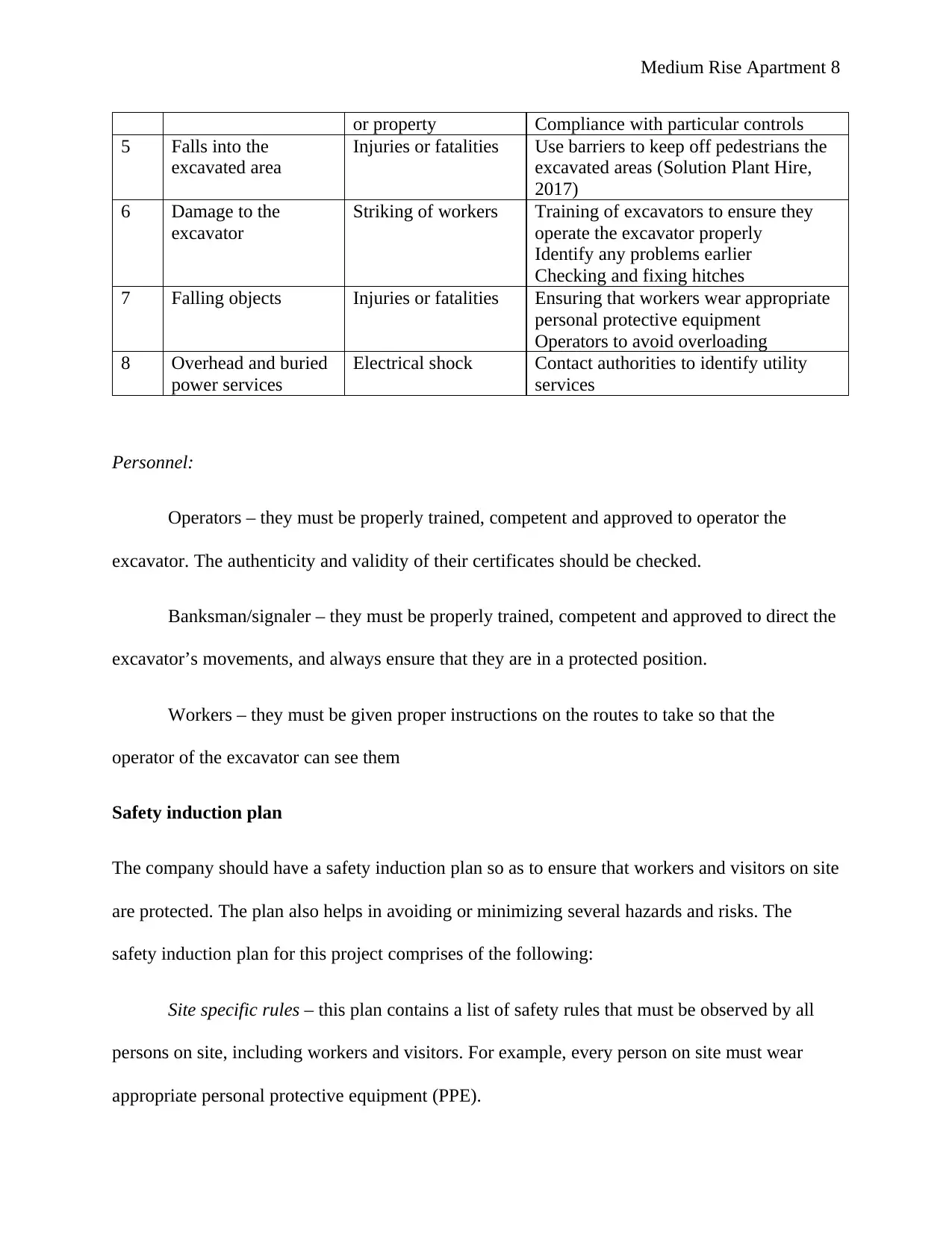
Medium Rise Apartment 8
or property Compliance with particular controls
5 Falls into the
excavated area
Injuries or fatalities Use barriers to keep off pedestrians the
excavated areas (Solution Plant Hire,
2017)
6 Damage to the
excavator
Striking of workers Training of excavators to ensure they
operate the excavator properly
Identify any problems earlier
Checking and fixing hitches
7 Falling objects Injuries or fatalities Ensuring that workers wear appropriate
personal protective equipment
Operators to avoid overloading
8 Overhead and buried
power services
Electrical shock Contact authorities to identify utility
services
Personnel:
Operators – they must be properly trained, competent and approved to operator the
excavator. The authenticity and validity of their certificates should be checked.
Banksman/signaler – they must be properly trained, competent and approved to direct the
excavator’s movements, and always ensure that they are in a protected position.
Workers – they must be given proper instructions on the routes to take so that the
operator of the excavator can see them
Safety induction plan
The company should have a safety induction plan so as to ensure that workers and visitors on site
are protected. The plan also helps in avoiding or minimizing several hazards and risks. The
safety induction plan for this project comprises of the following:
Site specific rules – this plan contains a list of safety rules that must be observed by all
persons on site, including workers and visitors. For example, every person on site must wear
appropriate personal protective equipment (PPE).
or property Compliance with particular controls
5 Falls into the
excavated area
Injuries or fatalities Use barriers to keep off pedestrians the
excavated areas (Solution Plant Hire,
2017)
6 Damage to the
excavator
Striking of workers Training of excavators to ensure they
operate the excavator properly
Identify any problems earlier
Checking and fixing hitches
7 Falling objects Injuries or fatalities Ensuring that workers wear appropriate
personal protective equipment
Operators to avoid overloading
8 Overhead and buried
power services
Electrical shock Contact authorities to identify utility
services
Personnel:
Operators – they must be properly trained, competent and approved to operator the
excavator. The authenticity and validity of their certificates should be checked.
Banksman/signaler – they must be properly trained, competent and approved to direct the
excavator’s movements, and always ensure that they are in a protected position.
Workers – they must be given proper instructions on the routes to take so that the
operator of the excavator can see them
Safety induction plan
The company should have a safety induction plan so as to ensure that workers and visitors on site
are protected. The plan also helps in avoiding or minimizing several hazards and risks. The
safety induction plan for this project comprises of the following:
Site specific rules – this plan contains a list of safety rules that must be observed by all
persons on site, including workers and visitors. For example, every person on site must wear
appropriate personal protective equipment (PPE).
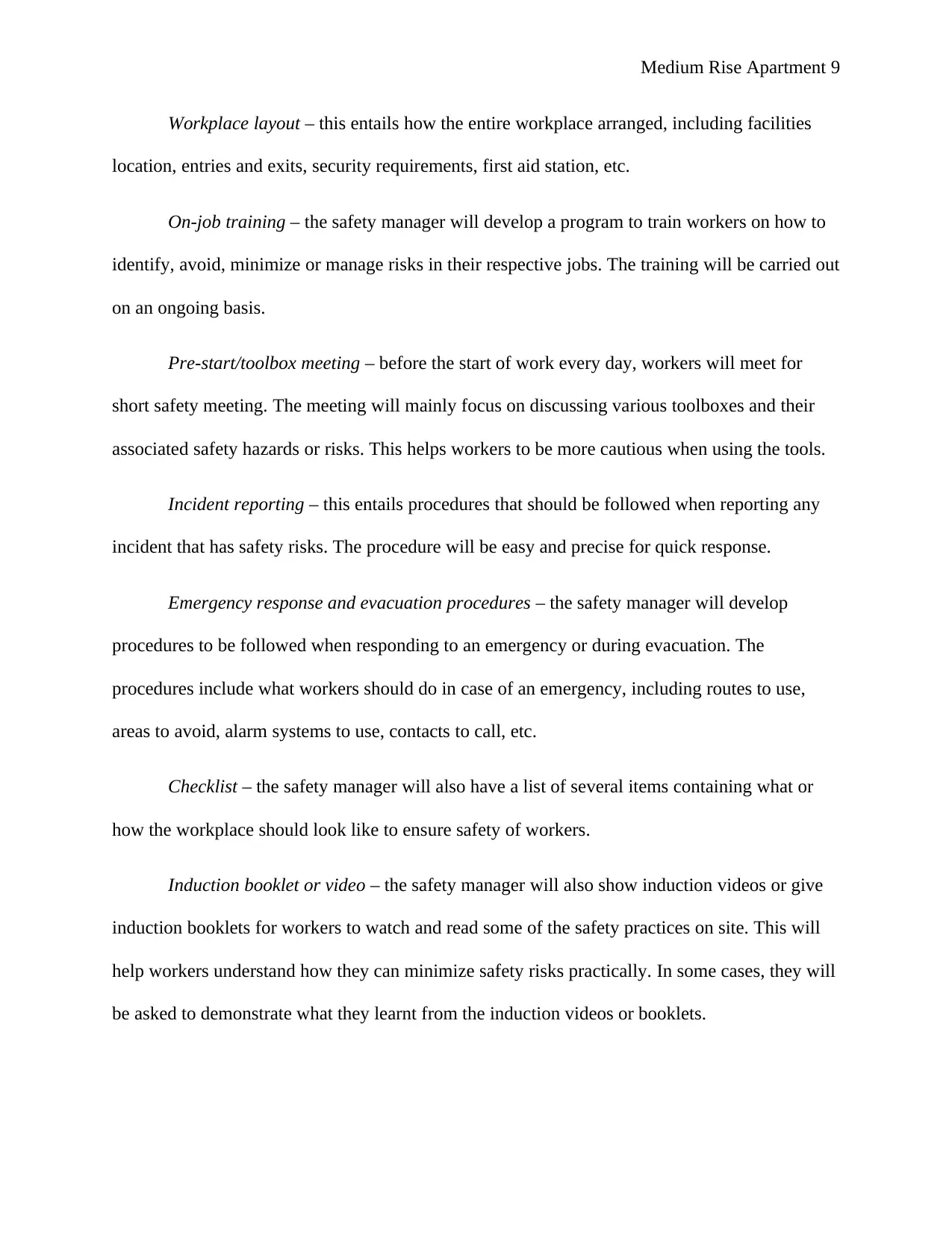
Medium Rise Apartment 9
Workplace layout – this entails how the entire workplace arranged, including facilities
location, entries and exits, security requirements, first aid station, etc.
On-job training – the safety manager will develop a program to train workers on how to
identify, avoid, minimize or manage risks in their respective jobs. The training will be carried out
on an ongoing basis.
Pre-start/toolbox meeting – before the start of work every day, workers will meet for
short safety meeting. The meeting will mainly focus on discussing various toolboxes and their
associated safety hazards or risks. This helps workers to be more cautious when using the tools.
Incident reporting – this entails procedures that should be followed when reporting any
incident that has safety risks. The procedure will be easy and precise for quick response.
Emergency response and evacuation procedures – the safety manager will develop
procedures to be followed when responding to an emergency or during evacuation. The
procedures include what workers should do in case of an emergency, including routes to use,
areas to avoid, alarm systems to use, contacts to call, etc.
Checklist – the safety manager will also have a list of several items containing what or
how the workplace should look like to ensure safety of workers.
Induction booklet or video – the safety manager will also show induction videos or give
induction booklets for workers to watch and read some of the safety practices on site. This will
help workers understand how they can minimize safety risks practically. In some cases, they will
be asked to demonstrate what they learnt from the induction videos or booklets.
Workplace layout – this entails how the entire workplace arranged, including facilities
location, entries and exits, security requirements, first aid station, etc.
On-job training – the safety manager will develop a program to train workers on how to
identify, avoid, minimize or manage risks in their respective jobs. The training will be carried out
on an ongoing basis.
Pre-start/toolbox meeting – before the start of work every day, workers will meet for
short safety meeting. The meeting will mainly focus on discussing various toolboxes and their
associated safety hazards or risks. This helps workers to be more cautious when using the tools.
Incident reporting – this entails procedures that should be followed when reporting any
incident that has safety risks. The procedure will be easy and precise for quick response.
Emergency response and evacuation procedures – the safety manager will develop
procedures to be followed when responding to an emergency or during evacuation. The
procedures include what workers should do in case of an emergency, including routes to use,
areas to avoid, alarm systems to use, contacts to call, etc.
Checklist – the safety manager will also have a list of several items containing what or
how the workplace should look like to ensure safety of workers.
Induction booklet or video – the safety manager will also show induction videos or give
induction booklets for workers to watch and read some of the safety practices on site. This will
help workers understand how they can minimize safety risks practically. In some cases, they will
be asked to demonstrate what they learnt from the induction videos or booklets.
⊘ This is a preview!⊘
Do you want full access?
Subscribe today to unlock all pages.

Trusted by 1+ million students worldwide
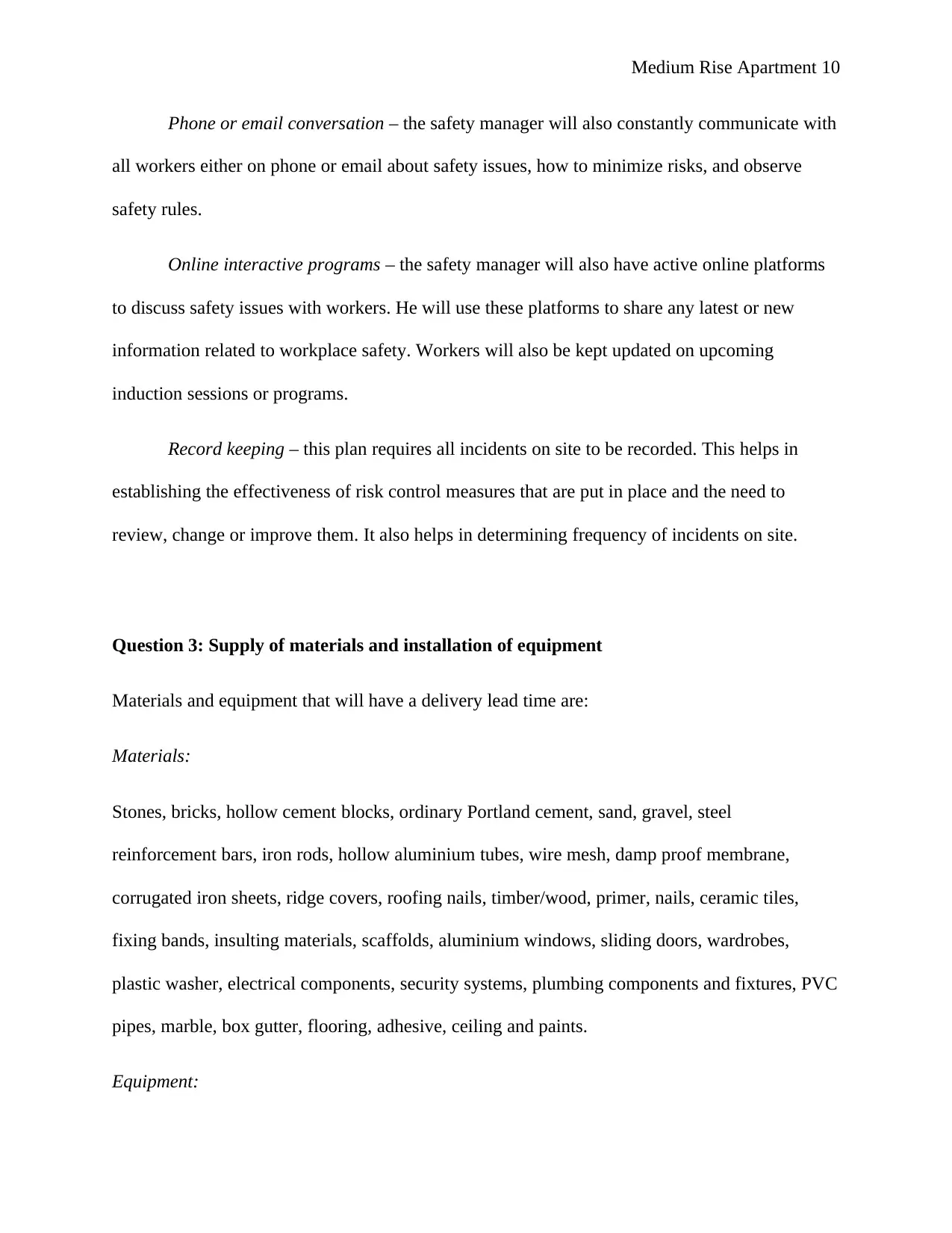
Medium Rise Apartment 10
Phone or email conversation – the safety manager will also constantly communicate with
all workers either on phone or email about safety issues, how to minimize risks, and observe
safety rules.
Online interactive programs – the safety manager will also have active online platforms
to discuss safety issues with workers. He will use these platforms to share any latest or new
information related to workplace safety. Workers will also be kept updated on upcoming
induction sessions or programs.
Record keeping – this plan requires all incidents on site to be recorded. This helps in
establishing the effectiveness of risk control measures that are put in place and the need to
review, change or improve them. It also helps in determining frequency of incidents on site.
Question 3: Supply of materials and installation of equipment
Materials and equipment that will have a delivery lead time are:
Materials:
Stones, bricks, hollow cement blocks, ordinary Portland cement, sand, gravel, steel
reinforcement bars, iron rods, hollow aluminium tubes, wire mesh, damp proof membrane,
corrugated iron sheets, ridge covers, roofing nails, timber/wood, primer, nails, ceramic tiles,
fixing bands, insulting materials, scaffolds, aluminium windows, sliding doors, wardrobes,
plastic washer, electrical components, security systems, plumbing components and fixtures, PVC
pipes, marble, box gutter, flooring, adhesive, ceiling and paints.
Equipment:
Phone or email conversation – the safety manager will also constantly communicate with
all workers either on phone or email about safety issues, how to minimize risks, and observe
safety rules.
Online interactive programs – the safety manager will also have active online platforms
to discuss safety issues with workers. He will use these platforms to share any latest or new
information related to workplace safety. Workers will also be kept updated on upcoming
induction sessions or programs.
Record keeping – this plan requires all incidents on site to be recorded. This helps in
establishing the effectiveness of risk control measures that are put in place and the need to
review, change or improve them. It also helps in determining frequency of incidents on site.
Question 3: Supply of materials and installation of equipment
Materials and equipment that will have a delivery lead time are:
Materials:
Stones, bricks, hollow cement blocks, ordinary Portland cement, sand, gravel, steel
reinforcement bars, iron rods, hollow aluminium tubes, wire mesh, damp proof membrane,
corrugated iron sheets, ridge covers, roofing nails, timber/wood, primer, nails, ceramic tiles,
fixing bands, insulting materials, scaffolds, aluminium windows, sliding doors, wardrobes,
plastic washer, electrical components, security systems, plumbing components and fixtures, PVC
pipes, marble, box gutter, flooring, adhesive, ceiling and paints.
Equipment:
Paraphrase This Document
Need a fresh take? Get an instant paraphrase of this document with our AI Paraphraser
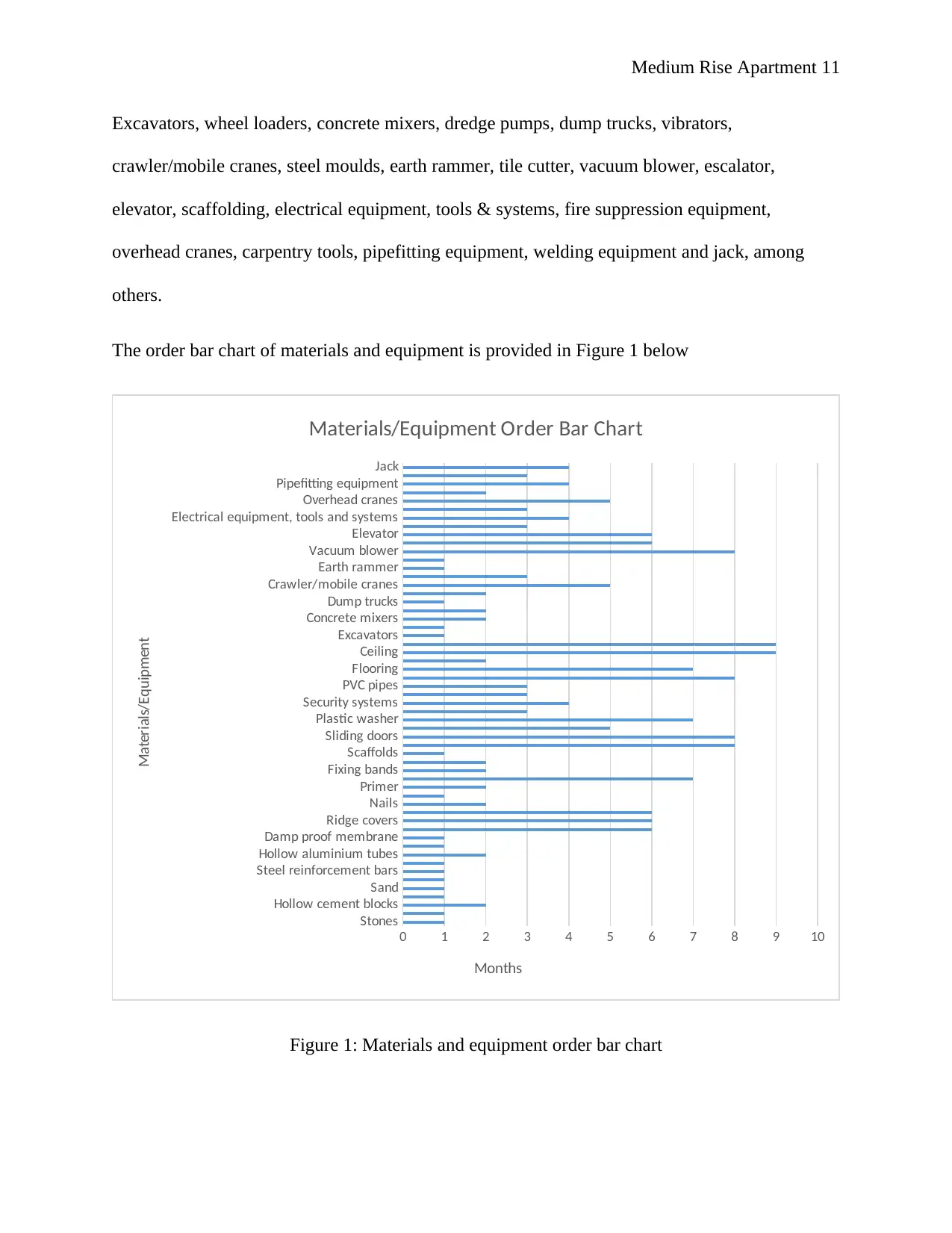
Medium Rise Apartment 11
Excavators, wheel loaders, concrete mixers, dredge pumps, dump trucks, vibrators,
crawler/mobile cranes, steel moulds, earth rammer, tile cutter, vacuum blower, escalator,
elevator, scaffolding, electrical equipment, tools & systems, fire suppression equipment,
overhead cranes, carpentry tools, pipefitting equipment, welding equipment and jack, among
others.
The order bar chart of materials and equipment is provided in Figure 1 below
Stones
Hollow cement blocks
Sand
Steel reinforcement bars
Hollow aluminium tubes
Damp proof membrane
Ridge covers
Nails
Primer
Fixing bands
Scaffolds
Sliding doors
Plastic washer
Security systems
PVC pipes
Flooring
Ceiling
Excavators
Concrete mixers
Dump trucks
Crawler/mobile cranes
Earth rammer
Vacuum blower
Elevator
Electrical equipment, tools and systems
Overhead cranes
Pipefitting equipment
Jack
0 1 2 3 4 5 6 7 8 9 10
Materials/Equipment Order Bar Chart
Months
Materials/Equipment
Figure 1: Materials and equipment order bar chart
Excavators, wheel loaders, concrete mixers, dredge pumps, dump trucks, vibrators,
crawler/mobile cranes, steel moulds, earth rammer, tile cutter, vacuum blower, escalator,
elevator, scaffolding, electrical equipment, tools & systems, fire suppression equipment,
overhead cranes, carpentry tools, pipefitting equipment, welding equipment and jack, among
others.
The order bar chart of materials and equipment is provided in Figure 1 below
Stones
Hollow cement blocks
Sand
Steel reinforcement bars
Hollow aluminium tubes
Damp proof membrane
Ridge covers
Nails
Primer
Fixing bands
Scaffolds
Sliding doors
Plastic washer
Security systems
PVC pipes
Flooring
Ceiling
Excavators
Concrete mixers
Dump trucks
Crawler/mobile cranes
Earth rammer
Vacuum blower
Elevator
Electrical equipment, tools and systems
Overhead cranes
Pipefitting equipment
Jack
0 1 2 3 4 5 6 7 8 9 10
Materials/Equipment Order Bar Chart
Months
Materials/Equipment
Figure 1: Materials and equipment order bar chart
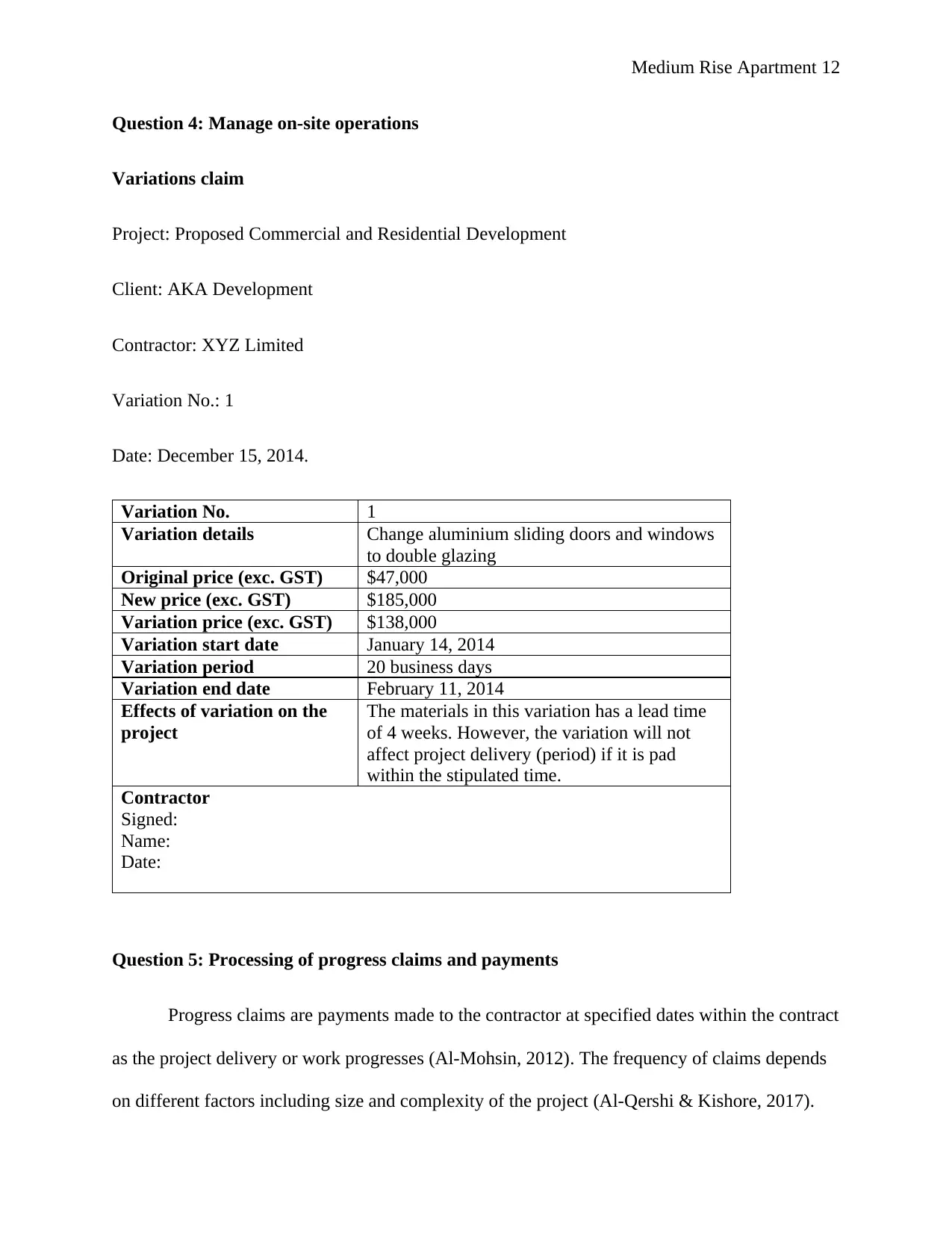
Medium Rise Apartment 12
Question 4: Manage on-site operations
Variations claim
Project: Proposed Commercial and Residential Development
Client: AKA Development
Contractor: XYZ Limited
Variation No.: 1
Date: December 15, 2014.
Variation No. 1
Variation details Change aluminium sliding doors and windows
to double glazing
Original price (exc. GST) $47,000
New price (exc. GST) $185,000
Variation price (exc. GST) $138,000
Variation start date January 14, 2014
Variation period 20 business days
Variation end date February 11, 2014
Effects of variation on the
project
The materials in this variation has a lead time
of 4 weeks. However, the variation will not
affect project delivery (period) if it is pad
within the stipulated time.
Contractor
Signed:
Name:
Date:
Question 5: Processing of progress claims and payments
Progress claims are payments made to the contractor at specified dates within the contract
as the project delivery or work progresses (Al-Mohsin, 2012). The frequency of claims depends
on different factors including size and complexity of the project (Al-Qershi & Kishore, 2017).
Question 4: Manage on-site operations
Variations claim
Project: Proposed Commercial and Residential Development
Client: AKA Development
Contractor: XYZ Limited
Variation No.: 1
Date: December 15, 2014.
Variation No. 1
Variation details Change aluminium sliding doors and windows
to double glazing
Original price (exc. GST) $47,000
New price (exc. GST) $185,000
Variation price (exc. GST) $138,000
Variation start date January 14, 2014
Variation period 20 business days
Variation end date February 11, 2014
Effects of variation on the
project
The materials in this variation has a lead time
of 4 weeks. However, the variation will not
affect project delivery (period) if it is pad
within the stipulated time.
Contractor
Signed:
Name:
Date:
Question 5: Processing of progress claims and payments
Progress claims are payments made to the contractor at specified dates within the contract
as the project delivery or work progresses (Al-Mohsin, 2012). The frequency of claims depends
on different factors including size and complexity of the project (Al-Qershi & Kishore, 2017).
⊘ This is a preview!⊘
Do you want full access?
Subscribe today to unlock all pages.

Trusted by 1+ million students worldwide
1 out of 18
Related Documents
Your All-in-One AI-Powered Toolkit for Academic Success.
+13062052269
info@desklib.com
Available 24*7 on WhatsApp / Email
![[object Object]](/_next/static/media/star-bottom.7253800d.svg)
Unlock your academic potential
Copyright © 2020–2025 A2Z Services. All Rights Reserved. Developed and managed by ZUCOL.





